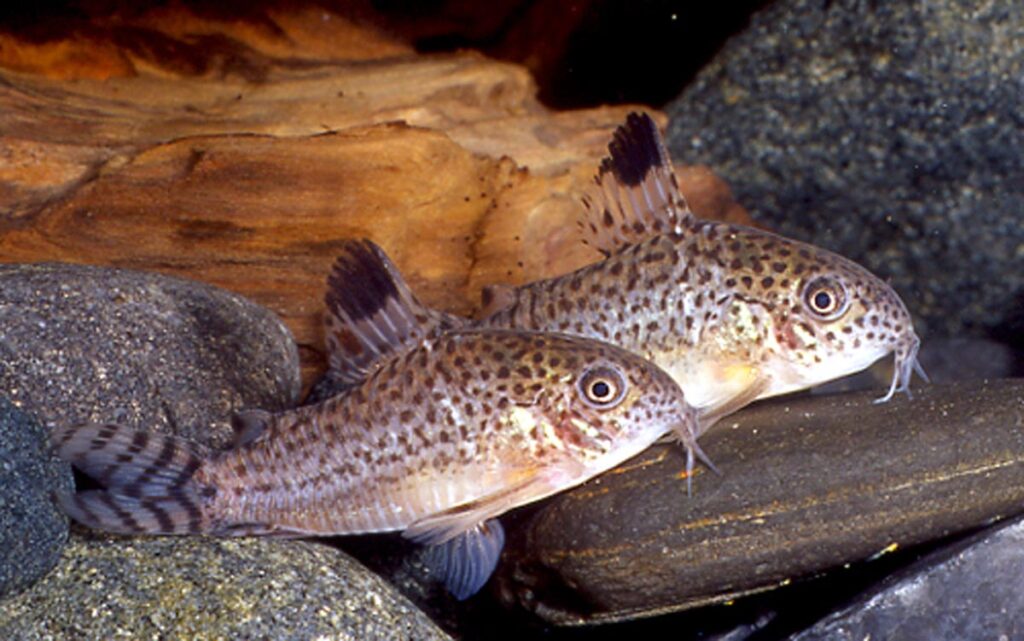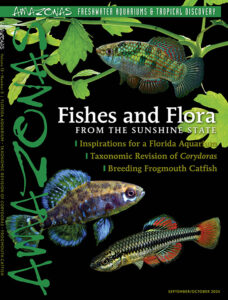
The long-awaited revision of the subfamily Corydoradinae has finally been published by Dias et al. on June 11, 2024, in the Zoological Journal of the Linnean Society. In the next issue of AMAZONAS, Hans-Georg Evers will detail the study results, but we wanted to give you a brief summary of what the revision contains.
Overall, there were few surprises, as Corydoras lovers have long known that the subfamily has become unwieldy and different groups could be clearly distinguished even if you are no scientist. Dias and colleagues concluded that all Corydoradinae have a single ancestor and identified seven groups that are now confirmed or resurrected at the genus level. These genera are Aspidoras, Brochis (resurrected), Corydoras, Gastrodermus (resurrected), Hoplisoma (resurrected), Osteogaster (resurrected), and Scleromystax.

In 2011, Alexandrou et al. proposed nine lineages (L1–L9) that have been used to group the subfamily but without formal group designations. Dias et al. largely followed Alexandrou et al.: Corydoras (L1; acutus or “saddle-snout group”), Aspidoras (L2), Scleromystax (L3), Gastrodermus* (L4; “Microcorydoras group” and L5; “elegans group”), Osteogaster (L7; “aeneus group”), Brochis (L8; Brochis and “long-snout group”), and Hoplisoma** (L6; “paleatus group” and L9; “puntatus group”), with two exceptions:
*The dwarf Corys (C. hastatus and C. pygmaeus) plus C. guapore and C. mamore; all in L4) at present could not be distinguished from group L5 (now Gastrodermus;), but that might change in future studies.
**L6 and L9 have been merged, making the round/short-snouted Hoplisoma the most species rich genus in the subfamily.
Despite the large step forward in clarifying the relationships among the vast subfamily Corydoradinae, there are still many open questions. For example, is Brochis splendens from Peru (the common Emerald Cory in the trade) actually valid as Brochis coeruleus (Cope, 1872)? Or are the numerous “Corydoras aeneus” populations found from Colombia all the way south to Argentina a species-complex/several yet unrecognized species, distinct from the namesake species Osteogaster aeneus (Gill, 1858) described from Trinidad? What is clear is that these populations are not a single species despite similar appearance and thus should be labeled Osteogaster aff. aeneus for the time being.
We will definitely have to relearn many names, but I am looking forward to the detailed report from our friend and founding AMAZONAS Editor Hans-Georg Evers coming in the September/October 2024 issue of AMAZONAS Magazine. Don’t miss it – subscribe now!
REFERENCES
Alexandrou, M.A., et al. 2011. Competition and phylogeny determine community structure in Müllerian co-mimics. Nature, 469: 84–88.
Dias, A.C. et al. 2024. Phylogenomic analysis in the complex Neotropical subfamily Corydoradinae (Siluriformes: Callichthyidae) with a new classification based on morphological and molecular data. Zoological Journal of the Linnean Society, XX, 1–31.






Good to see, but how long will it take for the “new” names to be widely used? Sites like IUCN usually take a long time to recognise changes.
I wonder when we are going to see USFWS confiscations of Corydoras imported under “invalid names”.
Hans Evers will be presenting at the All-Aquarium Catfish Convention Nov 1-3 in Burlington, VT, one of his talks will be specifically on the new revision to Cory’s, not too late to get registered.